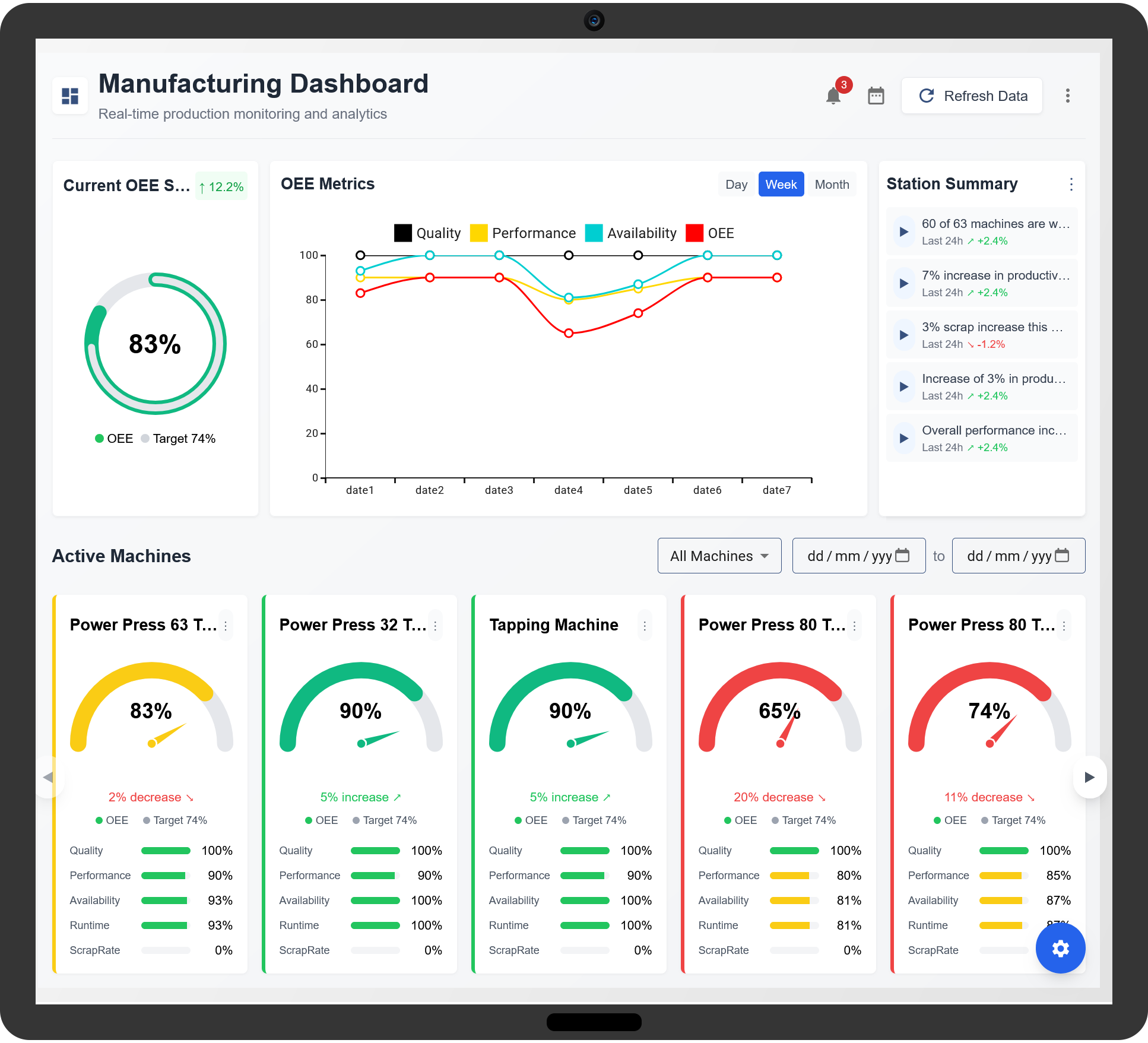Overall Equipment Effectiveness (OEE) is a key performance indicator (KPI) used in manufacturing to evaluate the efficiency and productivity of equipment. It provides valuable insights into how well machines are utilized by measuring three core factors: availability, performance, and quality. By tracking OEE KPIs, businesses can identify inefficiencies, minimize downtime, and improve overall productivity.

1. Understanding OEE KPI
OEE is calculated as a percentage, with 100% representing perfect production—meaning equipment operates without any downtime, at maximum speed, and produces defect-free products. The three main components of OEE are:
- Availability: Measures the percentage of scheduled production time during which equipment is available for operation.
- Performance: Evaluates whether machines are running at their maximum possible speed.
- Quality: Determines the proportion of defect-free products produced.
By multiplying these three factors, manufacturers can calculate their OEE score:
OEE = Availability × Performance × Quality
2. Key OEE Metrics
To effectively track and improve OEE, manufacturers must focus on several key metrics:
- Planned Production Time: The total available time for production, excluding scheduled breaks.
- Unplanned Downtime: Time lost due to equipment failures, lack of materials, or other disruptions.
- Cycle Time: The actual time taken to produce one unit compared to the standard expected time.
- Scrap Rate: The percentage of defective products that must be reworked or discarded.
- Throughput: The number of units produced within a given time frame.
3. How to Improve OEE in Manufacturing
Improving OEE requires a structured approach that focuses on minimizing downtime, optimizing performance, and enhancing product quality. Below are key steps to enhance OEE:
Step 1: Identify Equipment Downtime Causes
Tracking downtime reasons helps businesses understand whether issues are related to mechanical failures, operator inefficiencies, or supply chain disruptions.
Step 2: Implement Preventive Maintenance
Regular maintenance schedules help prevent unexpected equipment failures and extend machine lifespan.
Step 3: Optimize Production Speed
Machines should run at an optimal speed that balances efficiency and quality without overburdening equipment.
Step 4: Reduce Defect Rates
Improving quality control measures ensures that fewer products require rework, reducing waste and increasing efficiency.
Step 5: Utilize Real-Time Monitoring
Digital tracking tools provide instant insights into OEE metrics, allowing teams to react quickly to inefficiencies.
4. Benefits of Tracking OEE KPI
- Increased Productivity: Identifies inefficiencies and provides actionable insights to enhance production rates.
- Cost Reduction: Reducing downtime and defective products lowers operational expenses.
- Better Resource Utilization: Ensures that machines and labor are used effectively.
- Higher Quality Output: A focus on reducing defects leads to better product consistency.
- Data-Driven Decision Making: Real-time OEE tracking helps manufacturers make informed business decisions.
5. The Future of OEE KPI in Manufacturing
With the advancement of smart manufacturing, OEE tracking is becoming more automated. Data analytics, predictive maintenance, and AI-driven monitoring systems are helping manufacturers improve their OEE scores while maintaining operational flexibility. As businesses continue to embrace Industry 4.0 technologies, OEE will remain
OEE Kpi
What is OEE (Overall Equipment Effectiveness)?
OEE is a key performance indicator that measures the efficiency and productivity of manufacturing equipment.
Why is OEE important in manufacturing?
OEE helps manufacturers identify inefficiencies, reduce waste, and improve production performance.
How is OEE calculated?
OEE is calculated using the formula: Availability × Performance × Quality, expressed as a percentage.
What are the three components of OEE?
The three components are availability (uptime), performance (speed efficiency), and quality (defect-free production).
How does availability impact OEE?
Availability measures equipment uptime by considering planned and unplanned downtime.
What is the role of performance in OEE calculation?
Performance assesses whether equipment is running at optimal speed without slowdowns or minor stops.
How does quality affect OEE?
Quality measures the percentage of defect-free products, ensuring minimal waste and rework.
What is a good OEE percentage?
An OEE of 85% or higher is considered world-class, while most industries aim for at least 60-70%.
How can OEE be improved?
OEE can be improved by reducing downtime, optimizing production speed, and minimizing defects.
What are the common causes of low OEE?
Common causes include equipment breakdowns, slow cycles, changeovers, and quality defects.
How does downtime affect OEE?
Downtime reduces availability, lowering overall OEE and impacting production efficiency.
Can OEE be applied outside of manufacturing?
Yes, OEE principles can be used in logistics, healthcare, and service industries to optimize processes.
How often should OEE be measured?
OEE should be measured in real-time or at regular intervals to track performance and identify trends.
What tools are used to track OEE?
OEE can be tracked using manual logs, digital dashboards, or automated monitoring systems.
How does OEE contribute to continuous improvement?
By identifying inefficiencies and tracking performance over time, OEE drives continuous process improvements.